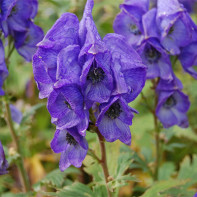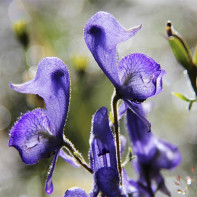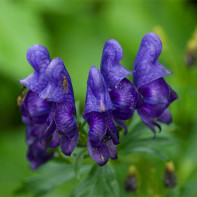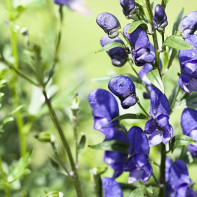Aconite: medicinal properties and contraindications
Aconite (wrestler) is a grassy perennial of the vast Lyutikov family. In the CIS countries, the plant is known as scutellaria, slipper, blue buttercup, blue eye, backache. In Russia, Ukraine and Belarus, there are more than three dozen local names of aconite. The wrestler has healing properties and is used in folk and official medicine.
Chemical composition
The ground part and roots of aconite contain alkaloids. These substances actively affect the human body. In small quantities, they have a therapeutic effect, and in large doses are poisons that are deadly to humans.
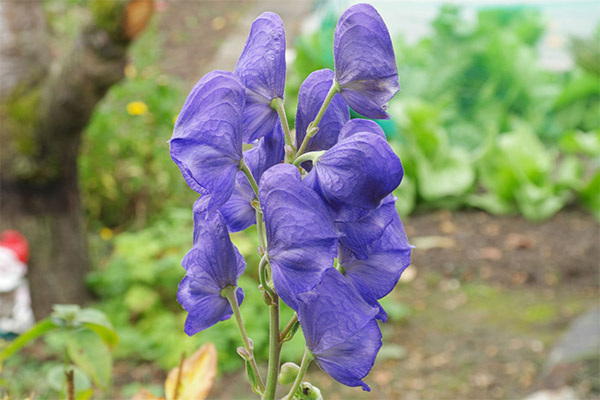
The plant contains aconitine. The substance is extremely toxic and belongs to neurotoxins. Varieties of aconitine (mesoaconitin, benzoaconitin, sasaakonitin, hetaaconitin, benzoylakonin) belong to the alkaloids of the first group.
The second group includes spartein, ephedrine and napallin. The total content of alkaloids in tubers and roots of aconite ranges from 0.9 to 4.9%.
The composition of plant materials of aconite also includes:
- saponins;
- tannins;
- coumarin;
- resins and resinous substances;
- various acids (fumaric, citric, benzoic);
- fatty acids (oleic, linoleic, myristic, palmitic, stearic);
- daucosterol;
- inositol;
- mesainodizole;
- starch and starchy compounds;
- flavonoids;
- Sahara.
Raw materials are rich in macronutrients. These are salts of iron and magnesium, potassium and calcium-containing substances. In the leaves and roots of the plant there are trace elements - zinc, chromium, barium, selenium, boron, copper, lead, nickel. The stems and leaves contain a large amount of vitamin C.
How it looks and where it grows
Representatives of the genus significantly differ in appearance, size, shape of leaves and flowers. The sizes of plants, the arrangement of inflorescences and the color of corollas also vary.
What does it look like
Plants of the genus Aconite have peculiar flowers. They do not look like flowers of the classical appearance of the Lyutikov family. Corollas resemble the flowers of lupine and other representatives of the legume family.
Large bright petals are in the form of a hood, an overhanging helmet, a bell, a cup. Most flowers are five-petalled. The upper petal is large, curved, it hangs over the central part of the flower and protects it from accidental damage. The color of the petals is lilac, blue, lilac, purple, yellow or white.
A nimbus is hidden inside the flower, transformed into 2 honey plants (nectaries), which secrete a sugary, sweet juice that attracts bees and other insects. The upper ovary is formed in the flower, in which 3 to 7 leaflets ripen. Dozens of small brown seeds are formed in them.
Aconite leaves are deep green, bright. They have a palmate-split and rounded shape and cover the stem from top to bottom. The height of the stems depends on the type of plant. The lowest representatives of the genus grow up to 60 cm in height, the highest species extend up to 200–220 cm.
The root system of a wrestler is constantly growing throughout the life cycle. Different species have 2 different root systems.
In the first case, this is a tuberous root, covered with a black shell, which grows 1-2 daughter tubers over the summer. They successfully winter and give rise to new aconites. The maternal tuberoid root either dies or survives the winter with young nodules. Thus, a chain of several rounded tubers is obtained. Sometimes their number reaches 10-15 pieces. Thin roots extend from the tubers wide and deep.
In the second case, the plant grows numerous, cord-like, long roots. They grow together and form a flat, strong, slightly twisted core root.
Where grows
The range of plants of the genus Aconite extends throughout Europe and North America. These flowers are ubiquitous in the forests of Asia. The wrestler loves nutritious soils rich in humus and organic acids, grows in forests and mountain meadows, on the moist shores of lakes and rivers, in fields and edges, along roads and irrigation canals.
Kinds
In the Northern Hemisphere, 330 species of the genus Aconite grow. 75 varieties of this plant are found on the territory of Russia and the CIS countries, of which 26 species of wrestler grows in Siberia, 37 in the Far East - Altai wrestler, white-breasted, white-purple, narrow-helmeted, Baikal, steppe, thick-leaved, lively leafed, Karakol, Dzungarian, mountain, napellus, buttercup, Sakhalin, curly. Dozens of representatives of the genus are named after biologists who have studied or discovered rare species.
In 1946, in the Soviet Union, two types of aconite - the Dzungarian wrestler and the Karakol wrestler were included in a special list - the State Pharmacopoeia, as medicinal plants. These species are found in the humid forested valleys of the Tien Shan.
In the middle zone of Russia there are 4 species of aconite. The northern wrestler grows throughout the East European Plain, but gravitates to higher latitudes. Wool-resistant wrestler is distributed up to the Ural ridge. Oak aconite is found only in areas of black earth. Flerov’s wrestler is a rare plant listed in the Red Book.
Collection and storage
The roots of aconite are harvested from August to October. At this time, the tubers had already formed and accumulated nutrients. Harvesters dig up tubers as well as thin roots. For work, you need a bayonet shovel. The dug raw materials are washed in clean water and dried. Drying is carried out in a ventilated room, under a canopy or on the veranda. Sunlight should not fall on raw materials. Drying temperature should not exceed 70 degrees Celsius.
Leaves, stems and flowers are collected at the height of flowering, in June-July. Greens are cut with a knife or scissors, sorted and dried under a canopy in a draft. Drying temperature should not exceed plus 30 degrees.
The plant is extremely toxic, during the preparation and processing of raw materials, skin contact with juice and root sections should be excluded. Harvesting is carried out in rubber gloves. After drying, the baking sheets and racks are thoroughly washed with running water.
Store the prepared raw materials in hermetically sealed glass jars in a dark, cool room. Storage should not be accessible to children and animals. The shelf life of dry aconite is 2 years.
The healing properties of aconite
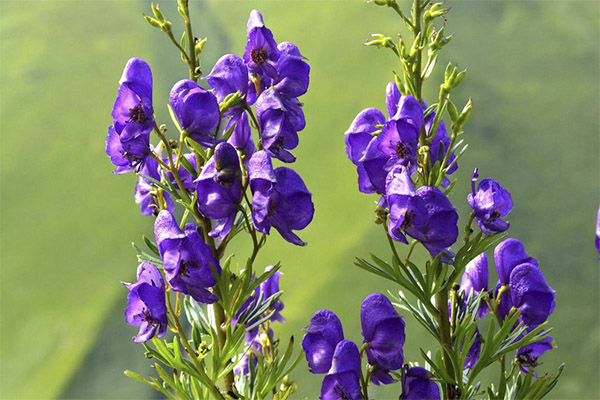
The unique chemical composition of aconite provides a complex effect on the human body. Plant-based medical and folk preparations provide:
- antibacterial;
- antipyretic;
- anti-inflammatory;
- painkiller;
- soothing;
- expectorant;
- antispasmodic;
- astringent;
- hemostatic;
- diuretic;
- estrogenic effect.
The drug Allapinin in tablets, the active substance of which is obtained from the roots of the white-breasted wrestler, is prescribed for the treatment of arrhythmia. The medicine also has a sedative, anesthetic and vasodilator effect.
Other aconite-based drugs manufactured by pharmacological enterprises, official medicine recognizes only as external funds. In pharmacies they sell alcohol tinctures, ointments, dried root. They are prescribed in the treatment of gout, rheumatism, neurological diseases, radiculitis.
Aconite in traditional medicine
In folk medicine, aconite-based products are used to treat dozens of diseases, using them both internally and externally. Recipes of reliable and effective drugs are passed from one generation of healers to another.
Extracts, decoctions and tinctures, the main ingredient of which is a wrestler, traditional healers treat tumors (benign and malignant), tuberculosis, cardiovascular pathologies, epilepsy, neurological diseases, including multiple sclerosis, nervous disorders.These drugs remove pain and inflammation in arthritis and arthrosis, radiculitis, osteochondrosis, reduce the severity of asthma attacks in adults, and also help to recover from lung diseases.
Healers consider the wrestler an effective remedy for migraine, gum disease and toothache. Traditional healers recommend taking inside infusions of aconite for arrhythmias. Decoctions and tinctures are advised to drink for any violations of the heart, weakness of blood vessels.
As an external agent, aconite-based preparations are used to wash suppurative, poorly healing wounds and fistulas, treat boils, and an abscess rash. Water infusions treat psoriasis, dermatitis, herpes zoster, erysipelas of the skin, neurodermatitis.
Aconite is used to restore blood circulation and reduce muscle pain. Broths rub the scalp to get rid of lice. Ingestion cleanses the body of worms and other helminths. Gargle treat stomatitis, gingivitis, throat infections. Prior to the appearance of antibiotics, solutions infused with aconite were used to treat sexually transmitted diseases.
Tincture for toothache and headache
To prepare the product, you need a bottle of vodka and 20 g of dried aconite root. Fresh raw materials are not used in this recipe.
The roots are crushed with a knife and poured into a glass jar, then poured with vodka. The jar is closed with a sealed lid. The container is put in a darkened place and kept at room temperature for 7-10 days.
The contents of the can are filtered to remove pieces of the root (some recipes recommend leaving the raw materials in alcohol). Ready tincture is stored in a cold place.
From headache, the drug is used externally. A tablespoon of tincture is rubbed (without strong pressure) into the scalp. The procedure is best done before bedtime.
To get rid of toothache, tincture is rubbed into the skin of the face, in the place where the diseased tooth and gums are located. It is not recommended to apply alcohol to the mucous membrane of the mouth. The procedures continue until the condition improves, with headaches the course is 1 month, but no more.
A decoction for the treatment of purulent skin diseases, boils and lavage wounds
To prepare a decoction, 15 g of dried aconite root are measured out and placed in an enameled pan (or a large mug). Pour the raw material with a glass of freshly boiled water, put the vessel on the stove and boil the broth for at least 20 minutes. Then remove from the burner, cover the container with a lid and allow to cool.
The skin, wounds, boils are treated with a cotton swab dipped in broth. The procedure is carried out 3-5 times a day.
Tincture to strengthen blood vessels and treat heart diseases
Tincture is prepared from dried roots of aconite and vodka. To prepare the product, you will need 10 g of raw materials and 2 bottles of vodka (1 l).
The roots are crushed, poured into a liter glass jar and poured with vodka. The vessel is tightly closed with a screw or plastic cover, kept in a dark cabinet for 3-4 days (at room temperature) and filtered. After this, the tincture is ready for use. Vodka can be replaced with medical alcohol with a strength of 60–70%. Store the product in the refrigerator.
Tincture is taken three times a day, 2 drops, 30-40 minutes before breakfast, lunch and dinner. The tool is dripped into a glass of water and drunk. The duration of treatment is best agreed with the doctor.
Arthritis Ointment
To prepare the product, you need 2 teaspoons of chopped aconite flowers and lard (unsalted). Take fresh, just bloomed flowers.
Flower raw materials are placed in a metal enameled container. They melt fat in a frying pan, over low heat and fill it with flowers.
The pot is placed on the stove, on a small fire. Stand for 15 minutes, constantly stirring fat. Then the capacity is transferred to the oven, included in the constant heating of 50-60 degrees. The drug is kept for 10-12 hours and removed from the oven.
If there is no electric or gas oven, you can simply wrap a saucepan and put it in a warm place - to the stove or heating battery for the same period of time. The finished product is stored in the refrigerator.
For treatment, ointment is rubbed onto the joint with rubbing movements.2-3 procedures are performed per day, the duration of the treatment course is 7 days. Then they take a week break and repeat the course again.
Pork fat can be replaced with pharmacy petroleum jelly, which does not contain aromatic and other additives. The technology for preparing the ointment does not differ from the preparation of the product with pork fat.
Alcohol tincture for the treatment of duodenal ulcers
To prepare the product, take 0.6 l of vodka and 20 g of dried root aconite. The raw materials are crushed, poured with vodka (or medical alcohol) and kept for a week in a residential building, in a darkened place (in a cupboard or buffet). After that, the liquid is filtered and closed with a sealed lid.
About daily and single doses should be consulted with a doctor, since alcohol irritates the mucous membranes. It is important that self-treatment does not give side effects.
Oil for pain in joints and muscles
To prepare the product, take 5-7 g of dry aconite root and a glass of vegetable oil (traditional healers recommend using olive). The roots are crushed, put in a metal enameled container and pour hot oil (250 ml). Place the vessel in a water bath, bring the water to a boil.
The oil is heated for 15 minutes. The tool is cooled, poured into a bottle or jar, tightly close the vessel with a lid.
The drug is applied to the joint and sore muscles 2–4 times a day. Rub the oil into the skin and make a light massage. The composition is well absorbed and does not irritate the skin.
Tincture for course administration in the treatment of diseases of internal organs
A teaspoon of dried aconite roots is crushed, poured with a bottle of vodka and insisted in a hermetically sealed container for 12-14 days. In the place where the product is infused, there should be room temperature, direct sunlight is not allowed to enter the container. The vessel is shaken daily. After the specified time, the liquid is filtered, the raw materials are squeezed and removed.
Course administration begins with 1 drop of the drug, which is added to 50 ml of water. 3 doses of this concentration are drunk per day (in the morning, at lunchtime and in the evening, half an hour before meals).
Every day, add 1 drop, bringing the concentration to 10 drops of tincture at each dose. Then the dose of aconite tincture is gradually reduced, counting down.
The duration of the course is 19 days. At the end of the course treatment, take a break of 1-1.5 months and repeat the tincture according to the same scheme.
Decoction for the treatment of shingles
To prepare the broth, you need 6 g of aconite leaves, 40 g of grass of a string, 4 glasses of water. The raw materials are crushed, mixed, put in an enamel pan and pour the plant components with boiling water. Then put the vessel on the stove, turn on the mode of small heating, bring the liquid to a boil and boil for 10-12 minutes. The pan is removed from the stove, covered with a lid and cooled. Ready broth is filtered.
For the treatment of shingles, a tissue napkin or cotton wool is moistened in a decoction and applied to diseased skin. The lotion is kept for 10 minutes. The procedure is recommended to be repeated twice a day.
Infusion of eczema and psoriasis in a thermos
For cooking, you will need dry plant materials: eucalyptus leaves (30 g) and aconite (3 g). If you have to use fresh plants, the leaves are pre-dried, and only then the right amount of plant material is measured on the scales.
The leaves are crushed and poured into a thermos. Then fill the raw materials with a glass of boiling water, close the lid and leave the vessel for 45-50 minutes. After this time, the infusion is filtered, poured into a large glass jar and diluted with 3 cups of hot boiled water.
Lotions are made to treat eczema and psoriasis. A tissue or cotton wool is moistened in the infusion and applied to the affected area for a quarter of an hour.The procedures are performed once a day, the duration of treatment should be agreed with a dermatologist.
Complex tincture for the treatment of epilepsy, goiter, neoplasms and polyarthritis
This complex product is prepared from the leaves, stems and flowers of a wrestler, collected in June or July. The medicine consists of 2 parts. Aconite alcohol tincture and a prefabricated herbal infusion with which it is mixed are separately prepared.
To prepare the tincture, take half a glass of dried leaves and flowers of a fighter. Raw materials are well crushed, filled with vodka (1.5 l) and incubated for 9-10 days in a dark room or in a closed cabinet. Then the liquid is filtered and poured into a glass vessel for storage.
After the ripening of the alcohol tincture, the second part of the product is prepared - the herbal infusion. To do this, you will need dry raw materials of clover, motherwort, flowers and a leaf of celandine, immortelle, dioica nettle. Peppermint grass, meadowsweet, plantain leaves, chicory flowers, sage leaf, heather, ripened hop cones will also be needed.
Measure the same amount of all ingredients and carefully chop the herbs (almost into flour). Then prepare the infusion. A teaspoon of herbal flour (without top) is brewed with a glass of boiling water, cover the vessel with a lid and incubated for 7-8 hours.
Take the tool as follows. Pour 50–70 ml of herbal infusion into a glass and add 5 drops of alcohol aconite tincture. Drink the drug three times a day, 30-40 minutes before eating.
This dosage (5 drops per dose) is maintained for 5 days. Then, every five-day increase the concentration of aconite tincture by 5 drops, bringing a single dose to 50 drops.
You should consult your doctor about the withdrawal of funds, as some traditional healers allow a sharp cessation of treatment, others believe that the exit should be smooth. Herbal infusion is not stored for more than a day and brewed daily.
Types of healing compounds
From dry roots and the ground part of aconite, infusions and tinctures, medicinal oils and ointments are prepared. The amount of raw materials in different recipes can vary significantly. But the general principles for the preparation of folk potions are the same.
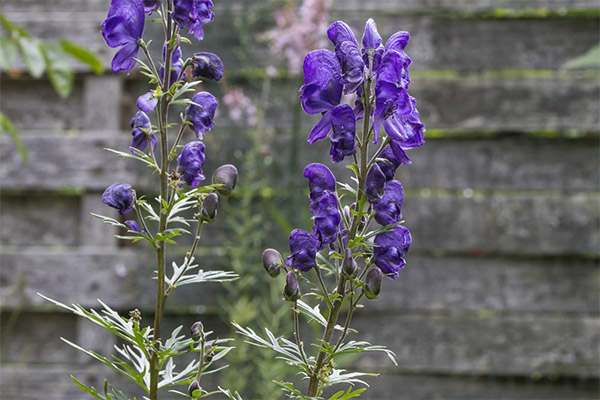
Infusion
Aconite infusions are prepared as tea, brewing crushed dry raw materials with boiling water and insisting it before cooling. Freshly picked leaves and flowers are dried first to prevent overdose (almost all available recipes include only dried material).
If heating is mentioned in the cooking procedure, it is done in a water bath. But there are many recipes that indicate simple boiling on the stove. If boiling takes more than 5 minutes, you should talk about preparing a decoction, not infusion.
Tincture
In the manufacture of aconite tincture, they take high-quality vodka or medical alcohol with a strength of up to 70 degrees. It can be diluted with boiled water to 40 degrees.
Dry raw materials are measured with a spoon (or on a kitchen scale), poured into a glass jar and poured with alcohol (vodka). Then the vessel is sealed.
Sunlight destroys the beneficial substances coming from the raw materials into the liquid, so tincture is removed in a dark place. The product can withstand the set time at a temperature of 15 to 24 degrees, after which the jar is opened and the contents are filtered. The tincture is ready, it can be used for several months.
Butter
Aconite oil is prepared on the basis of olive or sunflower fat component, dried root and green part of the plant. For cooking, use a small enameled pan or mug.
Measure the desired amount of dried aconite, put in a container and pour oil. In order to maximize the yield of nutrients, the vessel with the ingredients is placed in a boiling water bath and kept for the time specified in the recipe. After that, the product is cooled and used as intended.
Ointment
Ointments are made on the basis of petroleum jelly or lard (which is pre-heated on low heat). As an aconite raw material, take dried root and leaves or freshly picked flowers and leaves.
The ingredients are weighed, measured and combined in a metal enameled container. The vessel is placed in a water bath so that the fat component becomes liquid, and heated with constant stirring over low heat.
Then the container is removed from the bath, closed, wrapped in a towel and put in a warm place for 10-12 hours. During this time, plant materials will evaporate and release nutrients into the fat base. You can put the container in the oven, heated to a temperature of 50-60 degrees (for the same time). After cooling, the drug is used for medical procedures.
Contraindications

Poisonous alkaloids contained in the plant impose a number of restrictions on the use of drugs. Contraindications to the appointment are:
- pregnancy;
- breast-feeding;
- alcohol and drug addiction;
- hypertension and hypotension;
- renal failure;
- liver disease
- an allergic reaction to substances contained in plant materials and extracts;
- acute infectious diseases.
Drugs, which include a wrestler, are not prescribed for children and adolescents.
In case of accidental ingestion of dry raw materials, freshly picked leaves and flowers of a fighter, an overdose of pharmacy and folk remedies, you should immediately call an ambulance. The plant is highly toxic, in the absence of professional medical care, poisoning can become fatal. Before doctors arrive, you should drink plenty of water with activated charcoal and induce vomiting.
Traditional healers consider onions and sour milk as an antidote. But these remedies will only help with mild poisoning. Healers also recommend that when poisoning with infusion of poisonous aconite, drink an infusion of an antiviral fighter.
«Important: all information on the site is provided exclusively in fact-finding purposes. Before applying any recommendations, consult with a profile specialist. Neither the editors nor the authors are liable for any possible harm caused materials. "

